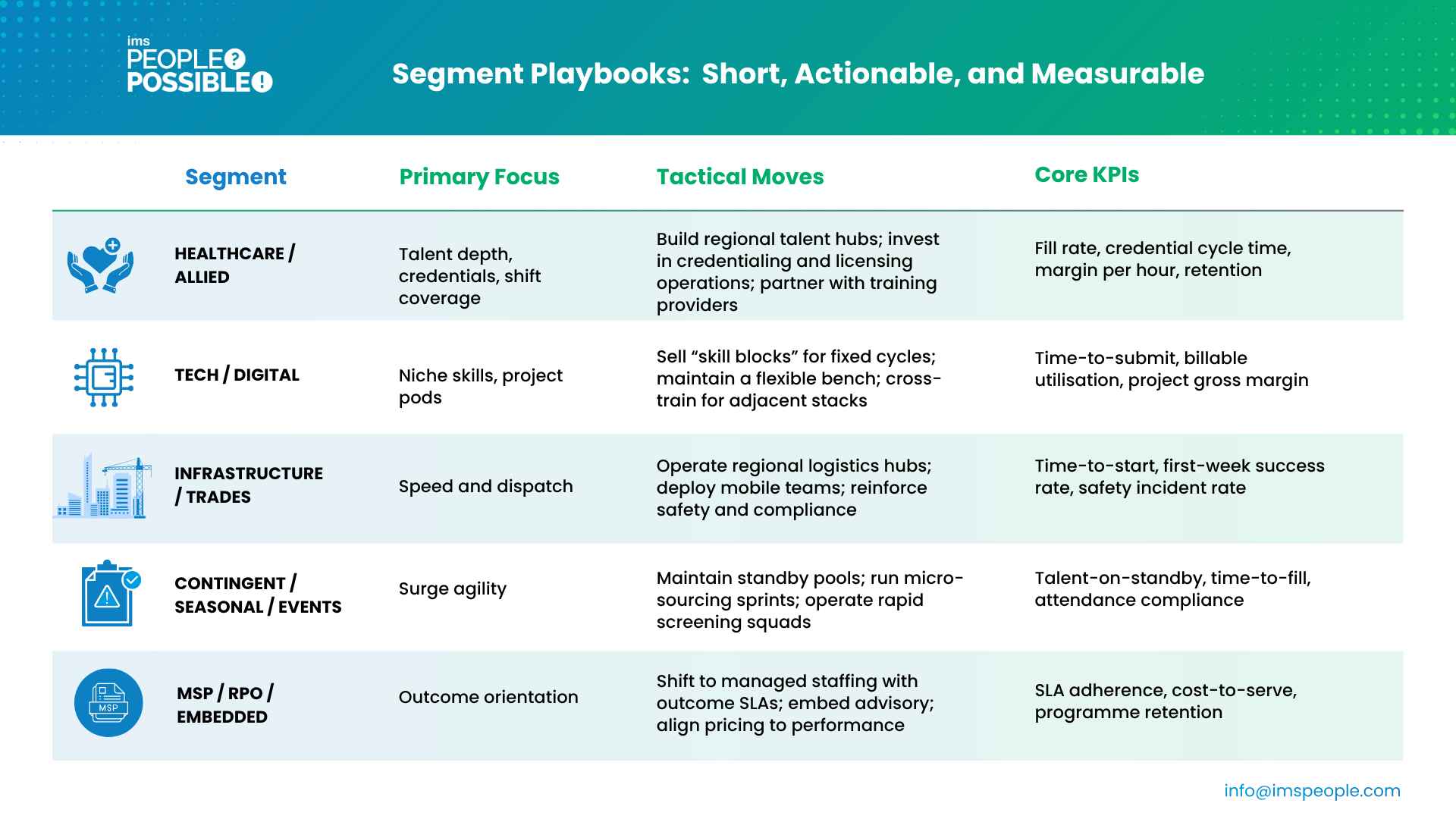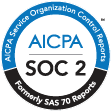The US staffing market in 2026 will be marked by disciplined, selective growth, not sweeping expansion. While overall growth may reach 1–3 %, the real story lies in strong divergence by sector, skill, and geography.
Agencies that focus deeply on niche domains, maintain margin discipline, and weave automation into every process will capture disproportionate value. The winning formula rests on three fundamentals:
- Target growth micromarkets
- Run tight, lean operations
- Embed AI across the full staffing lifecycle
Where Demand Will Grow in 2026
Healthcare & Allied Services
Demand will remain strong in nursing, home health, behavioural health, and telehealth due to persistent shortages. The highest growth will be in roles with strict credentialing and shift flexibility. Agencies with strong credentialing processes and regional talent pools will outperform.
Skilled Trades, Energy and Infrastructure
Ongoing investment in infrastructure, utilities, and renewable energy will keep electricians, technicians, installers, and line workers in demand. These roles are less vulnerable to short-term automation, helping sustain billable utilisation.
Technology and Digital (Specialised Domains)
Generic software hiring will be uneven, but demand for AI/ML, cybersecurity, cloud-native engineering, and data infrastructure will stay robust. Agencies that build narrow, high-quality pools and deliver “project-ready” teams will command premium margins.
Project-Based and Contingent Work
In sectors like construction, manufacturing, and retail, the shift toward contingent staffing is sharpening. The ability to mobilise quickly, turn resources on and off, and onboard fast will become a key competitive advantage.
Regional and Sector Nuances
Growth will concentrate in secondary metros, suburban hubs, and non-coastal regions. Local healthcare demand will vary based on demographics and public health. Thus, market selection and local credentialing capabilities will matter more than national trends.
Action point: Focus investment and effort where domain expertise, fast fills, and credential depth can drive margin uplift.
Operational Excellence Beats Headcount Gains
Simply adding more recruiters or seats will not move the needle in 2026. Growth will come from system quality, not sheer volume.
Manage by Margin
Measure success by margin per placement and contribution per recruiter, not just by volume. Enforce price discipline, control your cost-to-serve, and defend your rate cards.
Streamline Workflows & Funnel Hygiene
Define process stages clearly, eliminate unnecessary handoffs, and reduce redundancies. Track every lead → submission → interview → offer → start → bill. Monitor and repair “leaks” weekly.
Retain and Enable Recruiters
Reduce turnover by offering clear career paths, coaching, and enablement tools. Stable teams compound productivity and improve hiring quality.
Scalable Cost Structures
Adopt hybrid delivery models, shared services, or regional hubs to keep cost variable. Expand without locking into fixed overheads.
Data-Driven Feedback Loops
Deploy real-time dashboards that show pipeline health, fill probability, candidate dropout risk, and time-to-bill. Use operational reviews to trigger immediate remediation.
Expected outcome: Higher yield per recruiter, faster billing, and sustained margin improvement.
Make AI and Automation Systemic (Not Siloed)
AI is already touching recruiting operations. In 2026, winners will integrate it across the full staffing lifecycle.
- Advanced matching & ranking
Algorithms surface best-fit candidates, uncover hidden matches, and prioritise submissions. Recruiters spend less time researching, more time engaging. - Conversational agents & screening bots
Automate initial outreach, screening questionnaires, interview scheduling, and FAQs to shorten cycles and reduce dropouts. - Orchestrated workflow automation
Connect compliance checks, credentialing, offer creation, onboarding, and background checks into a seamless engine. - Predictive analytics & risk scoring
Detect candidates likely to drop out, clients at risk of churn, and requisitions with weak fill probability. Trigger interventions early. - Recruiter augmentation tools
Real-time assistants suggest coaching prompts, talk tracks, and sentiment insights to improve call performance and close rates.
Governance matters: Assign clear ownership, define adoption KPIs, and treat change management as a required investment. Technology only delivers when tightly integrated into daily operations.
Segment Playbooks: Short, Actionable, and Measurable

These playbooks provide a practical lens on staffing demand by industry 2026 and how targeted execution can unlock outsized returns.
Practical KPI Framework for 2026
- Growth: Net new clients, share-of-wallet, program expansion
- Velocity: Time-to-submit, time-to-start, time-to-bill
- Quality: First-month retention, redeployment rate, client NPS
- Unit Economics: Gross margin %, margin per placement, recruiter contribution
- Compliance: Credential cycle time, background check speed, audit pass rate
This framework aligns the 2026 staffing market reality with disciplined operations.
Pricing, Positioning, and the Shift to Solutions-Led Growth
Commodity pricing erodes margins. In 2026, competitive advantage will come from solutions that integrate talent, process, and measurable outcomes.
- Managed talent pools / Staffing-as-a-Service
Offer flexible, curated pools with rotation management, training, and SLA-backed delivery. - Outcome-based contracts
Tie your fees to performance metrics like uptime, quality thresholds, and productivity results. - Upskilling and workforce advisory
Embed training and development to raise worker productivity and client satisfaction. - Transparency through tech
Provide client portals for live access to pipelines, compliance status, and SLA tracking. - Risk, compliance and governance bundles
Deliver credentialing, background checks, and contractor governance as integrated services to reduce friction.
The shift is from “filling roles” to delivering outcomes and mitigating workforce risk.
IMS People Possible: A Partner for Solutions-Led Growth
IMS People Possible enables agencies to move beyond transactional supply toward outcomes-centric delivery in 2026.
- Managed talent pools with SLA-backed rotations and readiness as core staffing solutions
- Outcome-based engagement models that link fees to measurable performance
- Embedded upskilling and credentials management to accelerate time-to-bill
- Client transparency via real-time dashboards across pipeline, compliance, and SLAs
- Integrated risk, compliance, and governance services that de-risk programmes at scale
Impact for agencies: Faster velocity, higher fill reliability, stronger margins, and durable client retention across the US staffing industry forecast horizon.
Conclusion
The 2026 US staffing landscape rewards precision, systems, and measurable impact — not just scale. Agencies that focus on growth micro-markets, operational rigour, and AI-enabled workflows will exit the year with superior margins and stronger client relationships. Success will go to the operators who execute with discipline, measure what matters, and treat staffing as a solutions business.
Frequently Asked Questions
What is the US staffing outlook for 2026?
Moderate growth (1–3 %) with significant variance by sector and geography. The strongest opportunities lie in credential-intensive healthcare, skilled trades tied to infrastructure, and specialised digital domains.
Which strategies yield the highest margins?
Margin-based pricing, niche specialisation, fast credential cycles, and automation-driven cost-to-serve reduction generate the best unit economics.
Where should agencies begin investing in AI?
Start with matching & ranking engines, screening automation, and compliance orchestration—these deliver immediate gains in speed and conversion.
How can agencies minimise candidate dropout?
Apply predictive dropout scoring, streamline communications, enable self-scheduling, and speed up credential completion.









